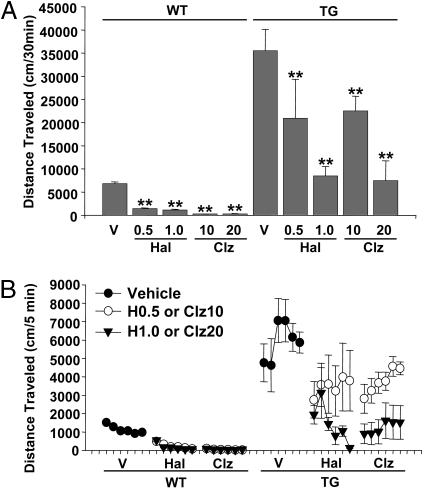Fig. 2.
Acute effects of antipsychotics on sensitized hyperactivity in BAC TG mice (316.23). Mice were tested in the open field for 8 days and received acute injections of vehicle (V), haloperidol (Hal; 0.5, 0.5 mg/kg; 1.0, 1.0 mg/kg; s.c.) or clozapine (Clz; 10, 10 mg/kg; 20, 20 mg/kg; s.c.) 30 min before testing on day 8. Horizontal locomotor activity was recorded for 30 min. (A) TG and WT mice differed (F1,91 = 190.03, P < 0.01) and the drugs significantly attenuated locomotor activity (F4,91 = 25.09, P < 0.01). The drugs reduced locomotor activity to different degrees in WT and TG mice, as evidenced by a significant interaction between genotype and treatment (F4,91 = 11.82, P < 0.01). Asterisks indicate a statistically significant difference from respective vehicle controls at 1% (**) levels, as determined by Newman-Keuls tests. Error bars represent ±SEM. n = 5-21 mice per group. (B) Locomotor activity at every 5 min for a 30-min session. The drugs differentially reduced locomotor activity during the session in WT and TG mice (genotype × drug × time, F20,455 = 20.02, P < 0.01). Both drugs reduced spontaneous locomotor activity in WT mice (F4,71 = 109.81, P < 0.01) significantly more during later time points (drug × time, F20,355 = 5.07, P < 0.01). The drugs reduced the sensitized hyperactivity in TG mice (F4,20 = 5.33, P < 0.01) in a time-dependent manner (drug × time, F20,100 = 2.20, P < 0.01). Error bars represent ±SEM. H0.5, Haloperidol 0.5 mg/kg; H1, haloperidol, 1.0 mg/kg; Clz10, clozapine 10 mg/kg; Clz20, clozapine 20 mg/kg.

